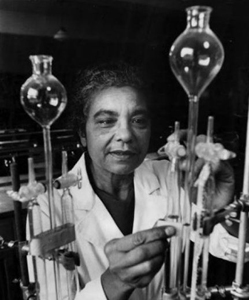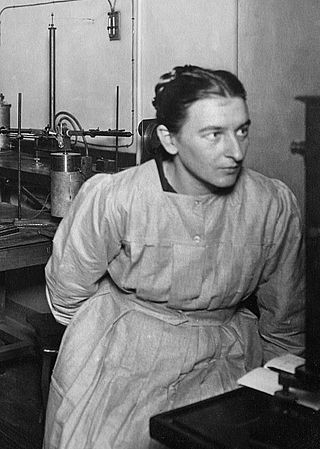Related Research Articles
Courtaulds was a United Kingdom-based manufacturer of fabric, clothing, artificial fibres, and chemicals. It was established in 1794 and became the world's leading man-made fibre production company before being broken up in 1990 into Courtaulds plc and Courtaulds Textiles Ltd.
Dorothy Jordan Lloyd was an early protein scientist who studied the interactions of water with proteins, particularly gelatin. She was also Director of the British Leather Manufacturers' Research Association. She was the first to propose that the structure of globular proteins was maintained by hydrogen bonds, an idea championed later by Linus Pauling and others.
Methylidynephosphane (phosphaethyne) is a chemical compound which was the first phosphaalkyne compound discovered, containing the unusual C≡P carbon-phosphorus triple bond.

Vera Yevstafievna Popova, née Vera Bogdanovskaya was a Russian chemist. She was one of the first female chemists in Russia, and the first Russian female author of a chemistry textbook. She "probably became the first woman to die in the cause of chemistry" as a result of an explosion in her laboratory.

Edith Ellen Humphrey was a British inorganic chemist who carried out pioneering work in co-ordination chemistry at the University of Zurich under Alfred Werner. She is thought to be the first British woman to obtain a doctorate in chemistry and the first chemist to synthesize a chiral inorganic complex.
Ada Florence Remfry Hitchins was the principal research assistant of British chemist Frederick Soddy, who won the Nobel prize in 1921 for work on radioactive elements and the theory of isotopes. Hitchins isolated samples from uranium ores, taking precise and accurate measurements of atomic mass that provided the first experimental evidence for the existence of different isotopes. She also helped to discover the element protactinium, which Dmitri Mendeleev had predicted should occur in the periodic table between uranium and thorium.
Kathleen Culhane Lathbury was a British biochemist known for her work with insulin and vitamins. Lathbury worked as an overseer at British Drug Houses where she was responsible for supervising the manufacture of insulin to make sure it was effective. After her retirement she took up painting and was exhibited in the Royal Academy. She was still driving at the age of 90. She had three sisters, Norah, Rosalind, Christine and two brothers, Robert, and Michael who all had equally remarkable lives

Janet Anne Galloway (1841–1909) was an advocate for higher education for women in Scotland, supporter of the Glasgow Association for the Higher Education of Women and secretary of Queen Margaret College.

Frances Mary Gore Micklethwait, was an English research chemist, among the first to study and seek an antidote to mustard gas during the First World War. She received an MBE for her top secret wartime work, which has since come to light.

Mary Elliott Hill was one of the earliest African-American women to become a chemist. She was known as both an organic and analytical chemist. Hill worked on the properties of ultraviolet light, developing analytic methodology, and, in collaboration with her husband Carl McClellan Hill, developing ketene synthesis which supported the development of plastics. She is believed to be one of the first African-American women to be awarded with a master's degree in chemistry. Hill was an analytical chemist, designing spectroscopic methods and developing ways to track the progress of the reactions based on solubility.

Margaret Seward MBE became the earliest Chemist on staff at the Women's College, from 1896 to 1915. She became the pioneer woman to obtain a first class in the honour school of Natural Science and later received an MBE for her work on nutrition during World War I.
Clare de Brereton Evans was a scientist and academic who became the first woman to be awarded a doctorate in Chemistry (DSc). She was a pioneer translator of Meister Eckhart's German works.

Elizabeth Eleanor Field was a British chemist and the Head of Chemistry at Royal Holloway College for over nineteen years. She is also noted as one of the nineteen signatories of the 1904 petition which aimed to grant women the status of Fellows of the Chemical Society.
Katherine Alice Burke was a British chemist and one of the nineteen signatories of the 1904 petition to the Chemical Society.
Alice Emily Smith was a British chemist and one of the nineteen signatories of the 1904 petition to the Chemical Society.

Stefanie Horovitz (1887–1942) was a Polish-Jewish chemist known for experimental work proving the existence of isotopes. Between approximately 1914-1918, she worked with Otto Hönigschmid at the Radium Institute of Vienna using analytical methods to demonstrate the first and second credible cases of isotopes in lead and thorium. Later she co-founded a home for children and young adults in need of psychological therapy. She was killed by Nazis at Treblinka extermination camp in 1942.
Margaret Elizabeth Buchanan was a British pharmacist and pioneer of women in pharmacy.
Mary Watson was a British chemist. She was one of the first two women to study Chemistry at the University of Oxford, the other one being Margaret Seward.
Frances Mary Hamer (1894–1980) was a British chemist who specialized in the sensitization compounds used for photographic processing for which she held many patents. She was very active in the Allied efforts to enhance aerial photography during World War I.

Catherine Chamié was a French chemist. Along with Irène Joliot-Curie, she first measured the Half-life of radon. She also undertook extensive research on the photographic effect of groupings of atoms, an effect which bears her name, known as Chamié effect.
References
- 1 2 3 4 5 6 7 8 9 "Furness, Vera (1921–2002)". Dictionary of Women Worldwide: 25,000 Women Through the Ages . 2006. Archived from the original on 20 January 2021. Retrieved 25 April 2021– via Encyclopedia.com.
- 1 2 3 Dallas, Zoë (25 August 1970). "With Women's Liberation" . StarPhoenix . p. 4. Retrieved 25 April 2021– via Newspapers.com.
- 1 2 3 4 5 F. Rayner-Canham, Marlene; Rayner-Canham, Geoff (2008). "Women Chemists in the 1940s – Vera Furness". Chemistry was Their Life: Pioneering British Women Chemists, 1880–1949. London, England: Imperial College Press. p. 513. ISBN 978-1-86094-986-9.
- 1 2 3 4 5 6 7 8 9 10 11 12 Haines, Catharine M.C.; Stevens, Helen M., eds. (2001). "Furness, Vera I.". International Women in Science – A Biographical Dictionary to 1950. Santa Barbara, California: ABC-CLIO. pp. 107–108. ISBN 1-57607-090-5.
- ↑ "Vera Isabella Furness". Companies House . Retrieved 25 April 2021.
- ↑ "No. 45384". The London Gazette (Supplement). 12 June 1971. p. 5966.